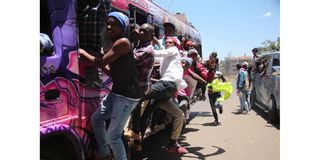Premium
Why ban on matatus from Nairobi CBD will be Badi's litmus test
What you need to know:
- President Uhuru Kenyatta, when he was the minister for Local Government in 2008, tried in vain to decongest the city centre by banning all buses and matatus from its streets.
- Former Nairobi Governor Dr Evans Kidero formed a task force incorporating different stakeholders in the transport sector in 2015.
- In December 2018, incumbent governor Mike Sonko revisited the matter, more determined to get it right.
Yet another plan that will see matatus removed from the Nairobi city centre by November has been mooted.
Nairobi Metropolitan Services Director-General Mohammed Badi wants matatus plying Thika Road to offload passengers in new bus stations at Ngara and Parklands, while those from Machakos and Lang’ata road will terminate their journeys at a yet to be built stage at the Railway Club.
Perfect plan? Yes, but if past experience is anything to go by, he might just be the one moving out of the city centre before the public service vehicles.

Nairobi Metropolitan Services Director-General Mohammed Badi.
In the past, magnificent plans to rid the city centre of matatus were floated by leaders, but all remained just that - plans. The city leaders ended up leaving their posts before actualising their plans.
President Uhuru Kenyatta, when he was the minister for Local Government in 2008, tried in vain to decongest the city centre by banning all buses and matatus from its streets.

President Uhuru Kenyatta, when he was the Minister for Local Government in 2008, tried in vain to decongest the city centre by banning all buses and matatus from the CBD.
The matatus came up with ingenious ways of accessing the city centre and life continued as normal.
Enter Governor Evans Kidero from the corporate world in 2013. The matatus lived out his five-year tenure on the streets of Nairobi.
Dr Kidero formed a task force incorporating different stakeholders in the transport sector in 2015.
The team visited Nairobi residents and collected views before they came up with recommendations to decongest the city.
Consequently, a May 12, 2017 gazette notice was issued, designating specific omnibus termini and routes within Nairobi for buses travelling through the city centre.
The notice indicated that all PSVs from Jogoo and Lusaka roads would pick and drop passengers at the Muthurwa terminus.

Former Nairobi Governor Dr Evans Kidero.
Those using Waiyaki Way, Uhuru Highway, Kipande and Limuru roads, would have their final stop at the Murang’a Road’s Fig Tree Terminus A, where those from Thika road would also go.
The PSVs that go past Ruiru but branch off before Kenol on the Nyeri/Meru-Nairobi Road, would end their journeys at Desai road terminus.
Those going past Kenol, together with all upcountry buses on Uhuru Highway, were to stop at Park Road terminus, while matatus using Juja Road, Ring Road Ngara and Park Road to enter the city centre were to stop at Ngara Road terminus.
All urban and peri-urban routes from Mombasa and Lang’ata roads were to use the Hakati terminus, and those from Ngong Road would stop at the Railway Station.
Finally, high capacity PSVs from upcountry were to be at the Machakos terminus, while matatus, including City Hoppa and Kenya Bus Service, which are on diametric multiple routes within the city would be stationed at the Central Bus Station.

Matatus parked at the Globe Roundabout in Nairobi.
Dr Kidero moved in to effect the gazette notice. He ordered all the PSVs parked in ungazetted areas to be towed to the county general stores, saying they were causing disorder and congestion.
But the matatu crew stayed put, vowing not to relent until they were allocated alternative parking areas. The governor changed his tone. He left office while the PSVs were still in the city centre.
Senator Mike Sonko took over as governor in August 2017.
What followed was a back-and-forth, with orders given and retracted. The matatus are still in town, while Mr Sonko surrendered the transport function to NMS.
Right after being sworn in, Mr Sonko said he would kick out matatus from the city centre. A month later, he suspended the plans for a month to allow the industry to self-regulate as the two parties looked for a permanent solution to the traffic problem.
Months passed, and in April 2018, the governor once again revisited the plan to ban matatus from the city centre. He ordered PSVs to terminate their journeys outside town.
The physically challenged and the elderly were to be ferried from their stages to the city centre by the buses that the National Youth Service had introduced a month earlier. But less than 14 hours later, the ban had been suspended, with the governor citing a lack of contingent measures before enforcement of the ban and need for time to allow more consultations with the affected parties.
“Let us all be proactive to resolve these endemic traffic gridlocks that threaten our existence and growth as a proud, emerging city. Let us all be the solution. Both at a personal and corporate level. Not just the PSVs,” he had said then.

Nairobi Governor Mike Sonko.
Mr Sonko gave matatu operators in the city three more months to shape up, adding that, in the meantime, only three vehicles per sacco would be allowed in.
Nothing happened. The matatus continued operating as usual.
In December 2018, the former Makadara MP revisited the matter, more determined to get it right. His administration tried to effect the May 12, 2017 gazette notice that had flopped during Dr Kidero’s tenure.
This only took effect for three days before suffering the same fate as others before it.
Matatu Owners Association chairman Simon Kimutai, at the time, said for such an order to succeed, enough parking spaces must be provided, holding grounds made available and a cashless matatu system introduced to end impunity by matatu crew, who used cash to buy their way out of trouble.
“The problem is the private vehicles as they form 95 per cent of the vehicles in the city centre,” he said.
Ever since, there have been on and off plans to achieve the ban on matatus in the city centre.
Matatu operators say the plans have been failing because the designated termini have only about 500 parking slots, yet there are more than 20,000 matatus entering the city centre each day.
They estimate that more than 5,000 public service vehicles ply the Jogoo Road route, Thika Road and Waiyaki Way have more than 3,000, Mombasa and Lang’ata road routes have more than 8,000, while Ngong Road has more than 1,000 matatus.
Experts in the transport sector hold the view that for decongestion of the city to succeed, private vehicles should first be discouraged from entering the town, pedestrian walkways should be improved to promote people walking to their destinations and thirdly, stricter public transport regulations be put in place.
Private vehicles can be kept out of the city centre by having fewer parking slots as well as fewer streets open to vehicles, says the Institute of Transport Development and Policy, the Africa Programme Director Christopher Kost.
“If there are fewer parking spots and the parking fee is increased to let’s say, Sh1,000, then very few cars would come into the city,” he said.
Research by the Kenya Institute for Public Policy Research and Analysis (Kippra) titled Nairobi Metropolitan Region Transportation Challenges in 2017 revealed that private vehicles account for 64 per cent of the traffic volume in Nairobi, but ferry just 22 per cent of the people who use Nairobi roads.

A matatu being driven dangerously along Nairobi's Moi Avenue on September 9, 2018.
Urban planner Constant Cap called for the introduction of cross-city routes as a way of ensuring the majority of people can move easily about the city, saying the lack of non-motorised transport infrastructure such as pedestrian walkways and cycling paths had made short walkable distances dangerous for pedestrians.
“There are no pedestrian walkways and no cycle paths for those who want to cycle. Like the stretch between Kempinski (Hotel) and the University of Nairobi, is very short, but very dangerous because there’s no place to walk,” said Mr Cap.
He further explained that a standard framework for the matatu sector is needed, especially in the model of vehicles that are used.
He suggests that 14-seater vans be scrapped and replaced with high capacity vehicles such as the shuttle buses.
A study conducted by the Japan International Cooperation Agency (Jica) showed that more than 80 per cent of public transport on trunk roads consists of 14-seater matatus, an ineffective use of the limited urban infrastructure that causes traffic congestion and accidents.

A matatu being driven dangerously along Nairobi's Moi Avenue on September 9, 2018.
It is the Jica report that recommended matatu route-cut at the city centre along major public transport corridors such as Thika Road and the consequent erection of termini at Globe Cinema Roundabout, Presidential Pavilion near Uhuru Park to cut off matatu routes to/from Ngong Road, and in Muthurwa to cut matatu routes to/from Jogoo and Enterprise roads.
Also, the expert urges the county to invest in mass public transport and buy buses to ferry passengers from the designated bus stations outside the city.
Another possibility is investing in light rail to Nairobi’s suburbs using the already existing railway station in town and several new stations serving various estates.





